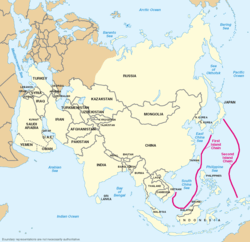Island Chain Strategy
The Island Chain Strategy is a strategy first mentioned by American foreign policy commentator John Foster Dulles in 1951 during the Korean War. It suggests surrounding the Soviet Union and China by sea.[1] The island chain concept did not become a major theme in American policy, but it has become a major fixation of Chinese analysts to this day. The concept heightens Chinese fears that they will be encircled by American forces, and emphasizes the geographical and strategic importance of Taiwan. It helps shape Chinese naval options and strategies, as well as playing a role in economic policy.[2]

Within Chinese writings, the Island Chain Strategy is divided into three parts, namely First Island Chain, the Second Island Chain and the Third Island Chain.
First Island Chain
The definition of the First Island Chain begins at the Kuril Islands, and finishes towards Borneo and the northern portion of the Philippines. It is the first chain to block socialist countries aligned with the USSR, and after Soviet Russia is dealt with the chain would then turn its focus on China. The key part of the first chain would be Taiwan.
Because the island chain is built up of a series of landmasses, it is also called the "unsinkable aircraft carrier", especially in reference to Taiwan.
Second Island Chain
The Second Island Chain can refer to two different interpretations, but the version most commonly used refers to the island chain which is formed by the Bonin Islands and Volcano Islands of Japan, in addition to Mariana Islands which is United States territory.
As it is located within the middle portion of the Pacific Ocean, it acts as a second strategic defense line for the United States.
Third Island Chain
The Third Island Chain is the final part of the strategy. Its island chain begins at the Aleutian Islands, and finishes up in Oceania. The key part of the Third Island Chain would be the Hawaiian Islands of the United States.
Target and events
The primary target of the doctrine was the USSR; however, additional targets also included the People's Republic of China and Vietnam. After the USSR collapsed in 1991, China soon became the major target of the doctrine.
References
- Umetsu, Hiroyuki (1996-06-01). "Communist China's entry into the Korean hostilities and a U.S. proposal for a collective security arrangement in the Pacific offshore island chain". Journal of Northeast Asian Studies. 15 (2): 98–118. doi:10.1007/BF03028144 (inactive 2020-06-06). ISSN 1874-6284.
- Yoshihara, Toshi (July 2012). "China's Vision of Its Seascape: The First Island Chain and Chinese Seapower: China's Vision of Its Seascape". Asian Politics & Policy. 4 (3): 293–314. doi:10.1111/j.1943-0787.2012.01349.x.